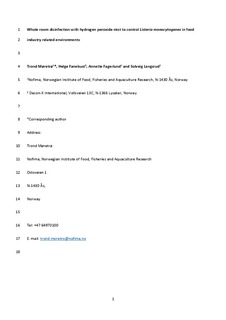| dc.description.abstract | Listeria monocytogenes surviving daily cleaning and disinfection is a challenge for many types of food industries. In this study, it was tested whether whole room disinfection (WRD) with H2O2 mist could kill L. monocytogenes under conditions relevant for the food industry. Survival of a mixture of four L. monocytogenes strains exposed to H2O2 mist was investigated in a 36 m3 room. A commercial machine produced H2O2 mist by pumping a 5% H2O2 solution containing 0.005% silver through a nozzle, and breaking the liquid up in droplets using pressurized air. When a suspension of bacteria in 0.9% NaCl applied on stainless steel coupons was exposed to WRD with H2O2 mist, a >5 log reduction (LR) of L. monocytogenes was observed. Similar reductions were observed in all tests with conditions between 12 and 20 °C, H2O2 concentrations of 35–80 ppm and 1–2 h exposure. It was shown that the H2O2 in the mist dissolved and accumulated in the liquid on the steel, and acted against L. monocytogenes in the liquid phase. At high cell concentrations, the effect was reduced if cells were pregrown at highly aerated conditions. The anti-listerial effect was robust against protein and fat, but the effect was quenched by raw meat and raw salmon, probably due to high catalase activity. The effect of whole room disinfection with H2O2 against dried L. monocytogenes cells was 1–2 LR, however the effect of air-drying by itself lead to 3–4 LR. When biofilms were exposed to WRD, no surviving L. monocytogenes were observed on stainless steel, however for L. monocytogenes on a PVC conveyor belt material, there were surviving bacteria, with about 2 LR. Screening of 54 L. monocytogenes strains for growth susceptibility to H2O2 showed that their sensitivity to H2O2 was very similar, thus WRD with H2O2 are likely to be robust against strain variation in susceptibility to H2O2. Production of H2O2 mist resulted in increased room humidity, and this may limit the maximum H2O2 concentration achievable, especially at low temperatures. The results in this study show that whole room disinfection with H2O2 may have potential to control L. monocytogenes in the food industry, however intervention studies in the food industry are needed to verify the effect in practical use. | |
